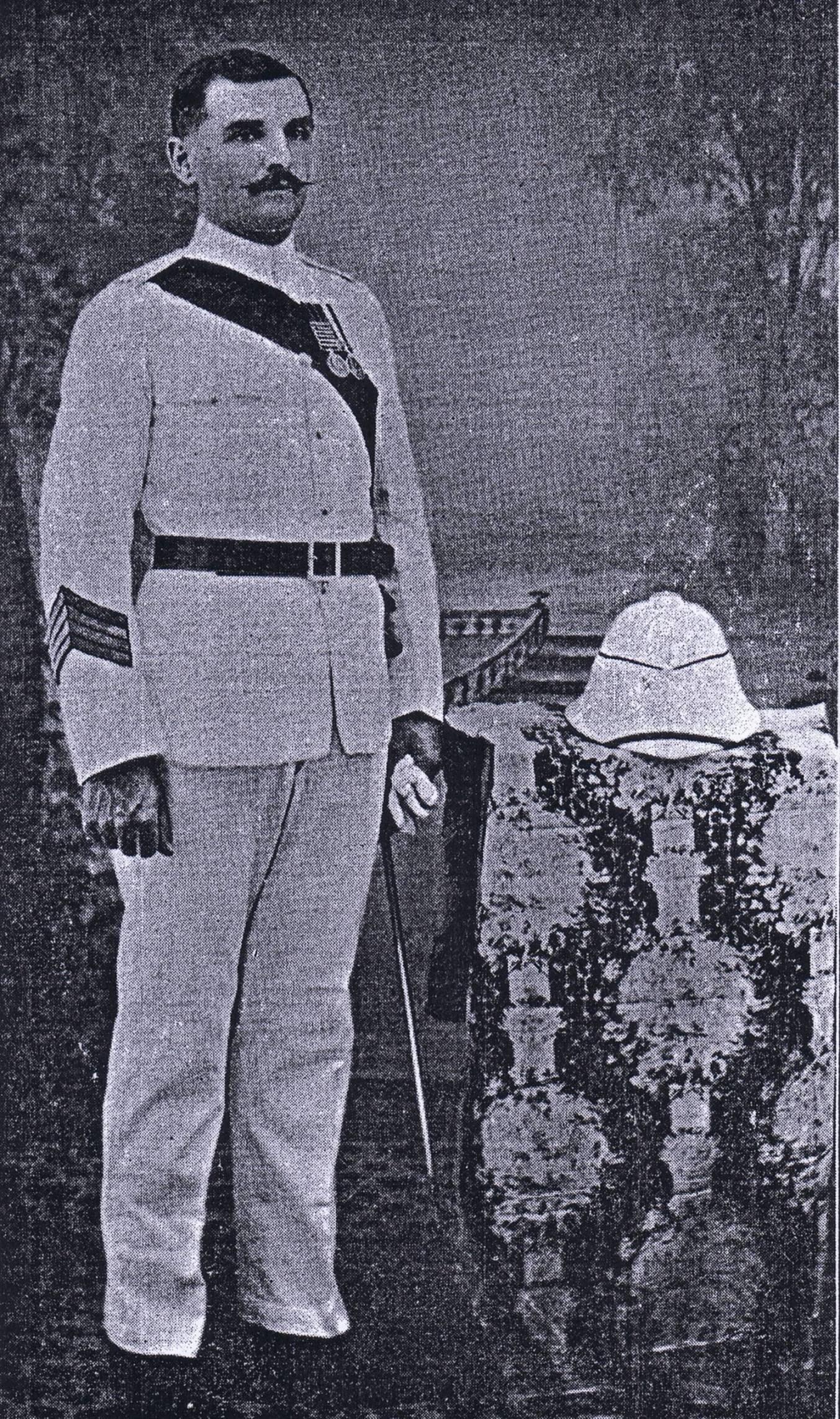
Researched by John Mills.
Born 27th of January 1880 Thomas was the son of Sergeant Valentine Goode also of the Yorkshire Regiment and his mother was called Helen. He was part of a large family; he had five brothers and two sisters.
He enlisted in Richmond on the 27th of August 1897. Being a first rate rifle shot he devoted himself to musketry and became an instructor. He served throughout the whole of the Boer War with the 1st Battalion. He was awarded the Queen’s medal with 6 clasps and the King’s with 2.
In 1905 he married Mary Agnes Grace Dobinson.
In 1914 he was with the 1st Battalion in India, his campaign medals indicate he was in France some time after 1915. He became a 2nd lieutenant in the Somerset Light Infantry (Prince Albert’s). He survived the war and retired with the rank of Captain on the 8th of June 1920.
He was awarded the M.B.E. on the 3rd of June 1919 for his services in connection with the war in India.
He must have returned to the army to serve in World War 2 because he has campaign medals (World War 2 service medal and war medal). Perhaps this might have been in some form of instructor role.
Explore more memories from the ribbon
-
John William Lodge
John was born on the 8th August 1855, the only son of Robert and Mary Lodge of The Rookery Bishopdale near Aysgarth. He was educated at St. Peter’s School, York and Gonville and Caius College, Cambridge. He graduated MA in 1879 and was called to the Bar at the Inner Temple, London in 1883. At 18, John had joined the 5th West York Militia, which became the 3rd Battalion Yorkshire Regiment in 1881. He would serve with the battalion in the 2nd Boer War (1899-1902). The Aysgarth parish magazine of June 1902 reported on his return from two years’ active service. “A large and enthusiastic crowd met him at the station, the West Burton Band playing appropriate airs. After much hand shaking and cheering, Mr Tomlinson in an admirable speech welcomed Colonel Lodge back to Wensleydale… After Colonel Lodge replied, giving a most interesting sketch of what he had had to do in South Africa, the band headed the procession from the station, Colonel Lodge riding in a wagonette with his sisters.” From 1906 until retirement in 1912 he would be the Battalion Commander. At the outbreak of the First World War, John offered his services and returned to his old Battalion as Major, remaining with it until May 5th 1916 when he was appointed to the command of a Garrison Battalion. As Squire of Bishopdale, Colonel Lodge was a Justice of the Peace for the North Riding and was on the Yorkshire Fisheries Board. He was a skilled angler…
-
Joseph Stoney
Information from Judith Farrar which relates to her husband Don’s great-uncle. Joseph Stoney’s occupation before the war as a stonemason, a skilled trade which places strenuous demands upon the worker’s hands. This was of some consequence following his attempt to enlist at the start of the First World War. He had previously been a territorial soldier with the West Yorkshire Regiment and when war broke out he naturally offered his services to his former regiment. His record shows that he was accepted, but that after only sixteen days he was discharged. The medical discharge paper records ‘Deformity of both thumbs, rheumatoid arthritis. Loss of gripping power. General debility.’ This judgement is reinforced by a second comment in a second hand, ‘Not likely to become an efficient soldier.’ This judgement did not deter Joseph from trying again, as his medal card attests. He managed to join the 1st Battalion, Yorkshire Regiment as 21581 Private J Stoney and was awarded the British War medal. Unfortunately John died either on the way out to India where the battalion was stationed, or when returning on leave. John died from dysentery on 10 May 1917 and is buried in the Cape Town (Maitland) Cemetery. His headstone appears to record the correct regimental number, but displays the West Yorkshire badge, rather than the Yorkshire Regiment.
-
Marguerite McArthur
Marguerite was born on the 25th March 1892 in Kensington London. From an early age she had a love of books. She attended Norland Place School in Notting Hill. It was soon apparent that she was academically gifted. She also excelled at sport, especially Hockey. During the war years she became Honorary Secretary of the Norland School Old Girls Association. Marguerite left school in 1908 and went on to higher education attaining First Class honours at the Cambridge Higher Local with a distinction in history. In 1910 she went to Dresden in Germany to study culminating in First Class Honours again with a distinction in spoken German. She was also fluent in French. In January 1911 went to Canada in what was a combines holiday/studying venture. October of that year would see her entering Clough Hall Newham College Cambridge to study further in the German language, again attaining First Class honours. At the outbreak of war Marguerite was employed by the Young Men’s Christian Society (YMCA). The Society had been established in London in 1844 as a prayer and bible study group. At the outbreak of war it turned their attention to providing support for servicemen. In November 1914, working with the BEF, it established centres in France. By 1918 there were over 300 centres. Marguerite would find herself working in the War Office Translation Bureau because of her language skills. From March 1918 Marguerite was part of the Army Education Service of the YMCA at Etaples on the northern…
